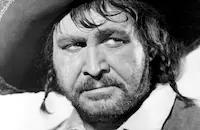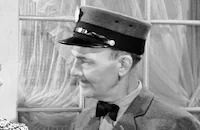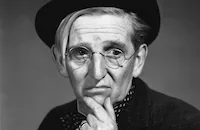Torchy Runs for Mayor

Brief Synopsis
Cast & Crew
Ray Mccarey
Glenda Farrell
Barton Maclane
Tom Kennedy
John Miljan
Frank Shannon
Film Details
Technical Specs

Synopsis
Reporter Torchy Blane repeatedly accuses Mayor Saunders of being in league with Dr. Dolan, who controls the city through graft. The articles worry policeman Steve McBride, Torchy's fiancé, because he believes that they place her in danger. By asking his allies to withdraw advertising from the newspaper, Dolan pressures Torchy's editor into cancelling her articles. Determined to prove that her articles are correct, Torchy searches Dolan's office and steals a small red book in which Dolan records his transactions. Dolan calls the police after the robbery, demanding the return of the book but also requesting that the theft receive no publicity. When Torchy writes an article exposing Dolan, the publisher of her newspaper refuses to print it. She takes her piece to other papers with no luck until she encounters Hogarth Ward, the publisher of a small, relatively unknown newspaper. With the help of Gahagan, Steve's partner, they distribute the publication all over town. Now that Torchy has revealed the mayor's corruption, the citizens choose Ward to run as a reform candidate. Before the election, however, Dolan kills Ward with an injection, using a letter he found in Ward's papers to place the blame for the murder on an innocent man. Because he is annoyed at her interference, Steve writes in Torchy's name as the new reform candidate. To his dismay, she decides to campaign seriously. From the podium, Torchy promises to name Ward's murderer, but before she can, she is kidnapped. Steve and Gahagan set off to find her. Steve threatens Dolan to no avail, but in the meantime, Steve has found an address that he believes to be the gang's hideout. They find Torchy and Dolan waiting there. Dolan and Steve fight and Dolan escapes in Steve's car, which Dolan's men have rigged to explode when the siren is used. Dolan is killed by the bomb. Torchy wins the election, but at the sight of a baby, decides to marry Steve instead of assuming the mayorship.

Director
Ray Mccarey
Cast

Glenda Farrell

Barton Maclane

Tom Kennedy

John Miljan
Frank Shannon
Joe Cunningham
George Guhl
Joe Downing

Irving Bacon

John Butler
Charles Richman
John Harron
Walter Fenner
Millard Vincent
Joe Devlin
Kenneth Harlan

Larry Williams
Jack Daley
Wedgewood Nowell
Fern Barry
Alice Connors

Jack Mower
Jack Goodrich

John Ridgely
Chester Gan
Tommy Bupp

James Conlin
Claude Wisberg
Stuart Holmes
Eddie Graham
Hal Craig
Dave Roberts
Jeffrey Sayre
Sidney Bracy
Kit Guard
Glen Cavender
Crew

Film Details
Technical Specs

Articles
Torchy Runs For Mayor
Torchy Runs for Mayor finds the "female newshound with a nose for news" entangled in local politics, digging up corruption in the administration of sitting mayor Saunders (Charles Richman) and stumping for reform candidate Hogarth Ward (Irving Bacon). When Bacon is murdered by poison injection, Farrell's indefatigable sob sister steps into the breach; before Torchy can expose the guilty party she is kidnapped, leaving Barton's irascible Lt. McBride to do what he does best - play the detective. The Torchy Blane films were intended by Warners to be nothing more than "dualers," B-pictures to be sent out in support of prestige releases. The critics (in particular, Bosley Crowther of the tony New York Times) were, in the main, unkind to the series, gleefully pointing out their plotting inconsistencies and lashing out at the main character (branded "the demon girl reporter" - a considerable slight against Farrell, a devout Catholic) with malicious sophistry where one might have expected film criticism. By the time of Torchy Runs for Mayor's release in May of 1939, The Times had given up on the franchise entirely. The trades, traditionally more forgiving, had grown cool to the Torchy sequels by this point, with the critic for Variety marking Torchy Runs for Mayor as "fully concocted for lower-deck dual fodder."
If the critics of the day failed to appreciate the charms of Torchy Blane, and her adventures largely forgotten, the character's influence was felt even as early as a year after the series' curtain call. Howard Hawks' His Girl Friday (1940) was a free adaptation of the Ben Hecht-Charles MacArthur stage play The Front Page, with newsman Hildy Johnson (Pat O'Brien in Lewis Milestone's 1931 film adaptation) gender-swapped for a tart-tongued lady reporter (Rosalind Russell, in a career-making star turn) molded in the Torchy Blane fashion (mannish suits, alpha dog determination). And just as His Girl Friday concludes with Russell's unstoppable Hildy Johnson forfeiting her professional life for married life with Cary Grant's sardonic editor Walter Burns, so had Torchy Runs for Mayor faded out with the newly-elected city official tossing her hat out of the political ring at the prospect of blissful domesticity. Knowing that Torchy fans would not want to see her dusting end tables and pinning nappies, Warners had Torchy Blane... Playing with Dynamite kick off with the protagonists back to their old ways, with no talk of setting up housekeeping, making the series conclusion feel less like a sequel than a busted reboot.
During production of the Torchy Blane series, Glenda Farrell's stock with the moviegoing public had risen to such a height that she was named honorary mayor of North Hollywood, beating out crooner-actor Bing Crosby and character player Lewis Stone for the honor. However ornamental the one-year appointment may have been, Farrell put in her time with the Rotary, Lions, and Kiwanis Clubs of the greater Los Angeles area and dedicated herself to the cause of installing sewers along Studio City's Ventura Boulevard. Farrell quit Warner Brothers after wrapping Torchy Runs for Mayor for work at MGM (Johnny Eager, 1941) and Columbia (The Talk of the Town, 1942), though the parts - and her billing - were nowhere as good. The only offer of a starring role came from Producer's Releasing Corporation, in the whodunit A Night for Crime (1943) - but any hope for a potential "Susan Cooper, Girl Reporter" series went sadly unrealized. In the 1950s, a mature and slower-speaking Farrell distinguished herself on the small screen, guesting on episodes of Wagon Train, The Defenders, and Route 66, and winning a Prime Time Emmy for her work on a 1963 Ben Casey two-parter. Perhaps best remembered today as the cop on Sam Spade's case in John Huston's The Maltese Falcon (1941), Barton MacLane also enjoyed a measure of TV immortality by capping his career playing the bellicose General Peterson on I Dream of Jeannie.
By Richard Harland Smith
Sources:
The Women of Warner Brothers: The Lives and Careers of 15 Leading Ladies by Daniel Bubbeo (McFarland and Company, 2002)
Girl Reporter: Gender, Journalism, and the Movies by Howard Good (Scarecrow Press, 1998)
Frank Capra and the Image of the Journalist in American Film by Joe Saltzman (Norman Lear Center- USC, 2002)
Mystery Movie Series of 1930s Hollywood by Ron Backer (McFarland and Company, Ltd., 2012)
The Female Investigator in Literature, Film, and Popular Culture by Lisa M. Dresner (McFarland and Company, 2006)
Detecting Women: Gender and the Hollywood Detective Film by Philippa Gates (State University of New York Press, 2011)

Torchy Runs For Mayor
Quotes
Trivia
Notes
The working titles of this picture were Torchy Blane Runs for Mayor and Torchy Blane for Mayor. This was the last film in the "Torchy Blane" series to star Glenda Farrell as "Torchy" and Barton MacLane as "Steve." In the next film in the series, Torchy Blane...Playing with Dynamite, which was the last, Jane Wyman became "Torchy" and Allen Jenkins became "Steve." For additional information about the series, consult the Series Index and see the entry above for Smart Blonde.















